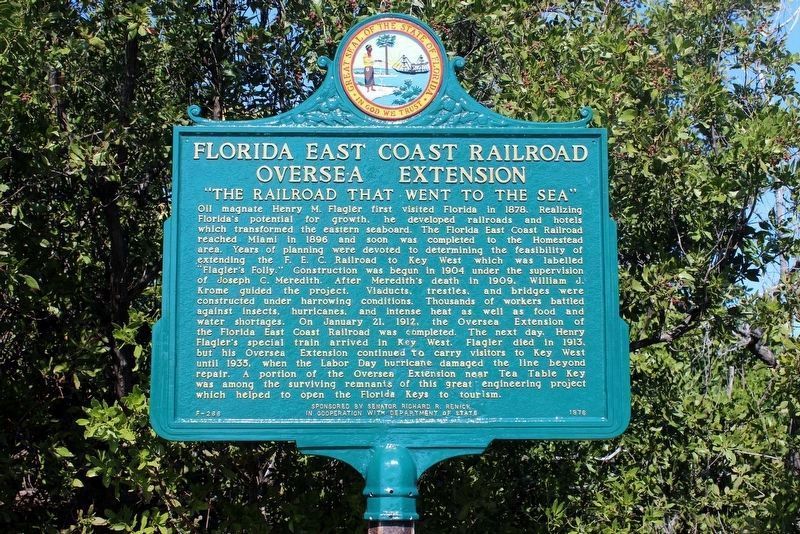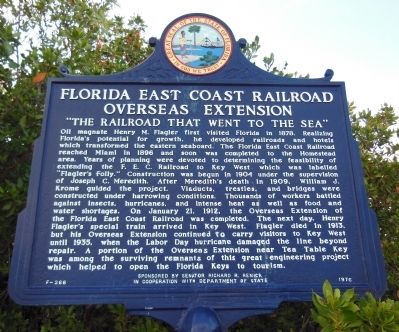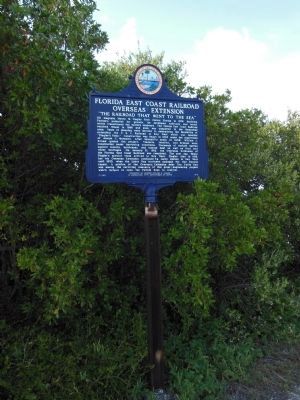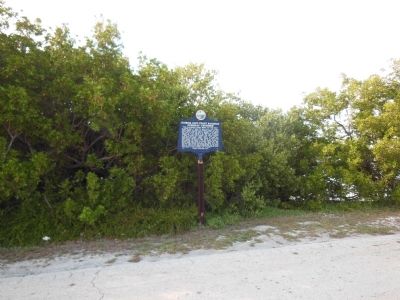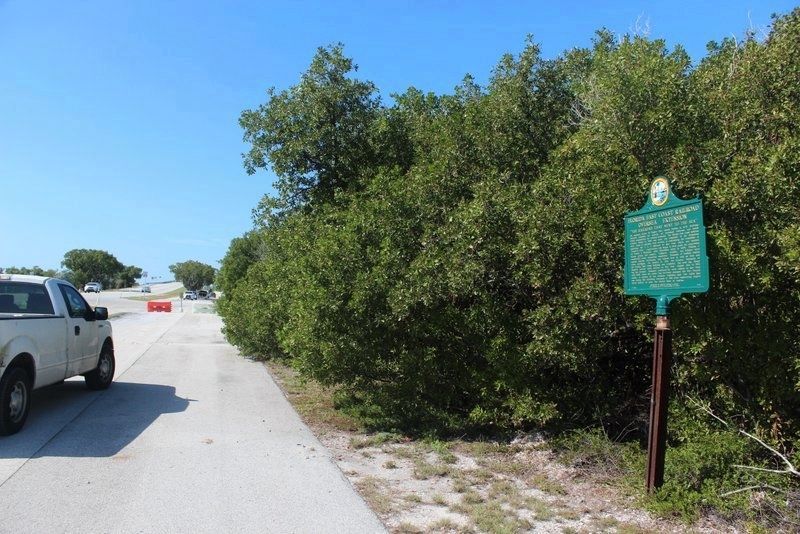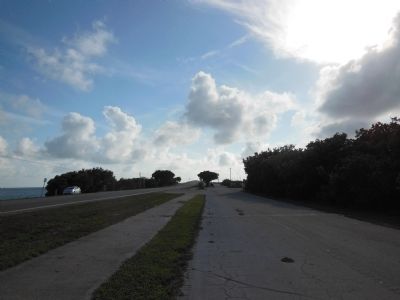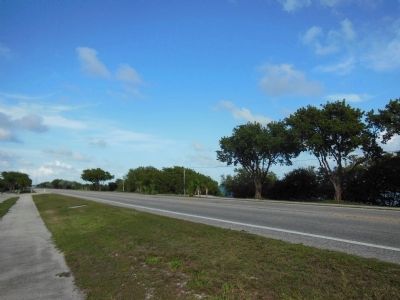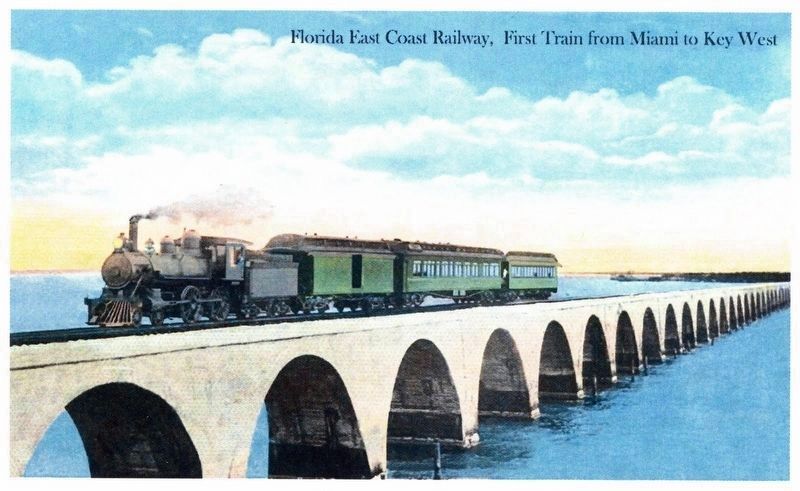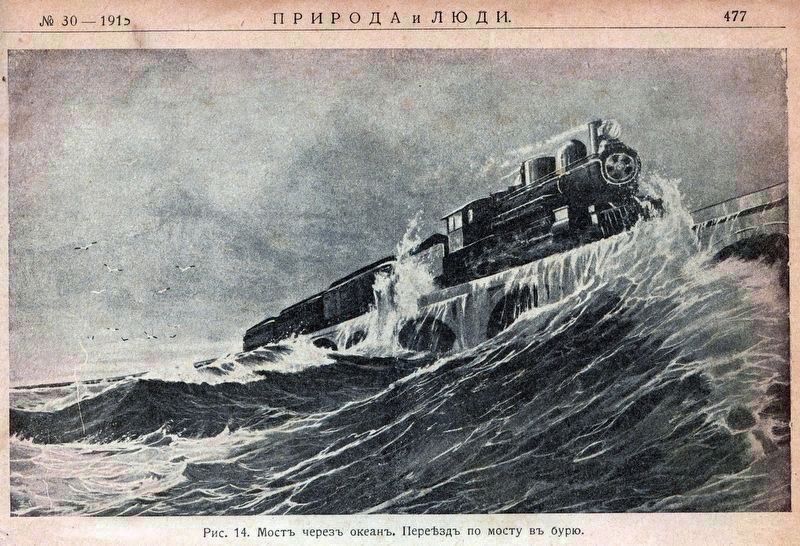Upper Matecumbe Key in Monroe County, Florida — The American South (South Atlantic)
Florida East Coast Railroad Oversea Extension
“The Railroad That Went to the Sea”
Inscription.
Oil magnate Henry M. Flagler first visited Florida in 1878. Realizing Florida’s potential for growth, he developed railroads and hotels which transformed the eastern seaboard. The Florida East Coast Railroad reached Miami in 1896 and soon was completed to the Homestead area. Years of planning were devoted to determining the feasibility of extending the F. E. C. Railroad to Key West which was labelled “Flagler’s Folly.” Construction was begun in 1904 under the supervision of Joseph C. Meredith. After Meredith’s death in 1909, William J. Krome guided the project. Viaducts, trestles, and bridges were constructed under harrowing conditions. Thousands of workers battled against insects, hurricanes, and intense heat as well as food and water shortages. On January 21, 1912, the Oversea Extension of the Florida East Coast Railroad was competed. The next day, Henry Flagler’s special train arrived in Key West. Flagler died in 1913, but his Oversea Extension continued to carry visitors to Key West until 1935, when the Labor Day hurricane damaged the line beyond repair.
A portion of the Oversea Extension near Tea Table Key was among the surviving remnants of this great engineering project which helped to open the Florida Keys to tourism.
Erected 1976 by Sponsored by Senator Richard R. Renick in cooperation with Department of State. (Marker Number F-266.)
Topics and series. This historical marker is listed in these topic lists: Bridges & Viaducts • Industry & Commerce • Railroads & Streetcars. In addition, it is included in the Florida East Coast Railroad and Hotels series list. A significant historical date for this entry is January 21, 1912.
Location. 24° 53.396′ N, 80° 40.549′ W. Marker is in Upper Matecumbe Key, Florida, in Monroe County. Marker is on Overseas Highway (U.S. 1) 1.8 miles south of Old U.S. 1, on the right when traveling south. Marker is located on Indian Key Fill, just north of the bridge across Indian Key Channel. Touch for map. Marker is in this post office area: Islamorada FL 33036, United States of America. Touch for directions.
Other nearby markers. At least 8 other markers are within walking distance of this marker. Spanish Treasure Fleet of 1733 (within shouting distance of this marker); Rafters (within shouting distance of this marker); Juan Ponce de Leon (within shouting distance of this marker); Triangle of History (about 500 feet away, measured in a direct line); Indian Key Historic State Park (about 500 feet away); San Pedro Underwater Archaeological Preserve (about 600 feet away); Tea Table Key (about 600 feet away); Indian Key (approx. 0.3 miles away).
Regarding Florida East Coast Railroad Oversea Extension.
It included 38 viaducts and bridges, including one 7 miles long, connecting the islands of the Florida Keys. Passengers reported that from their seats they would see tall ocean waves on both sides of their train as it crossed the longer bridges, just like as if they were at sea.
Also see . . .
1. Railroad workers constructing the Florida East Coast Railway's overseas extension.
Work on the oversea extension began in 1905. It was operational from 1912 until the Labor Day Hurricane of 1935. Financially unable to rebuild, the Florida East Coast Railway sold the roadbed and remaining bridges to the State of Florida, which built the Overseas Highway to Key West, using much of the remaining railway infrastructure. The extension was later added to the National Register of Historic Places in 1979 as Overseas Highway and Railway Bridges.(Submitted on April 5, 2014, by Cosmos Mariner of Cape Canaveral, Florida.)
2. The Railroad that Died at Sea. Copiously illustrated article by Ray Del Papa on the building, operations, and demise of the Oversea Extension. Excerpt:
During the 22 years that the railroad ran to Key West, the train that became the most synonymous with the run was The Havana Special. Originating at Penn station in New York City, the train traversed four different railroads (PRR, RF&P, ACL and FEC) before it reached Key West, 37¾ hours later. However, it was the fastest way Americans could(Submitted on January 15, 2021.)leave the “dry” United States and head for wet and wild Cuba. Needless to say, the train quickly became the pride of the FEC fleet. There was also a local passenger train that made the trip each way every day. This train would handle most of the mail and express business for the intermittent station stops along the way.
Two very important freight operations were a tank/water train, and the “Yellow Apparel,” the hot perishable train from Cuba. The tank/water train would load water at wells between Homestead and Florida City and then head south, delivering a vital supply of water to towns along the extension. Also this train would serve the many railroad water towers along the route; remember, steam locomotives used up plenty of water in their boilers. The hottest freight train on the line could be easily distinguished by the number of yellow refrigerated cars in its consist. Produce originating in Cuba would be loaded onto these yellow reefers and then in turn would be switched onto the car ferries. Once in Key West the cars would be switched off the ferry and then made into a train and rushed north. Since most of the refrigerated cars of the time were painted yellow the name “Yellow Apparel” was adopted. There was also a local freight that covered the route when needed.
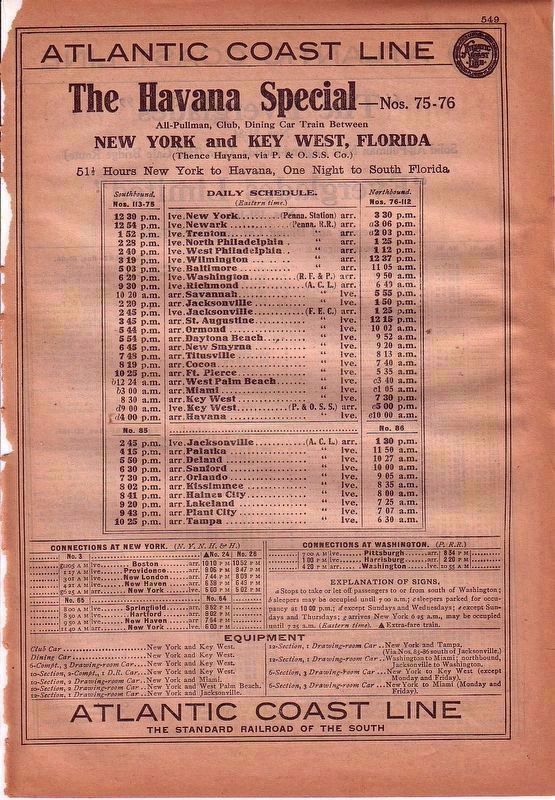
Timetable from The Official Guide of the Railways, December 1, 1925
10. The Havana Special — “51½ Hours New York to Havana”
Click on image to enlarge. This 1925 timetable shows daily first-class-only train departing New York City at half-past noon and arriving in Key West 44 hours later. A Peninsular and Oriental luxury steamship met the train in Key West and accepted the railroad ticket for the 7 hour voyage to Havana. The fare was around $55 one-way, or $715 in 2018 dollars. By 1933 speed had been improved to 37¾ hours to Key West and 6 more to Havana.
Credits. This page was last revised on February 18, 2021. It was originally submitted on April 5, 2014, by Cosmos Mariner of Cape Canaveral, Florida. This page has been viewed 1,260 times since then and 55 times this year. Last updated on May 25, 2020, by Tim Fillmon of Webster, Florida. It was the Marker of the Week January 17, 2021. Photos: 1. submitted on May 25, 2020, by Tim Fillmon of Webster, Florida. 2, 3, 4. submitted on April 5, 2014, by Cosmos Mariner of Cape Canaveral, Florida. 5. submitted on May 25, 2020, by Tim Fillmon of Webster, Florida. 6, 7. submitted on April 5, 2014, by Cosmos Mariner of Cape Canaveral, Florida. 8, 9, 10. submitted on January 15, 2021, by J. J. Prats of Powell, Ohio.
